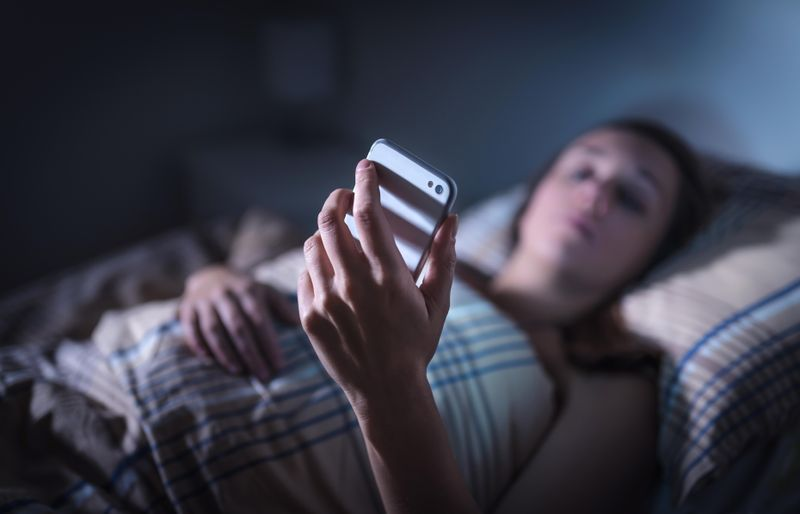Smartphone and Narrowed Arteries. Is it our bright future? No more huge machines… Existing diagnostic methods – ultrasound, CT and MRI – require screening with specialized medical imaging equipment and personnel… will no longer required soon.
Thank you for reading this post, don't forget to subscribe!A smartphone application could detect a blocked blood vessel in your neck, brain, heart etc, that could cause a stroke, a new study suggests. Yes it’s true, a videos may provide a non-invasive way to screen people who are at risk of stroke.
Nearly 87% of strokes are the ischemic type, which happens when fatty deposits build up in the carotid artery in the neck, blocking blood supply to the brain.
Motion analysis of video recorded on a smartphone accurately detected narrowed arteries in the neck. Analysis of video recorded on a smartphone is non-invasive and easy to perform, so it may provide an opportunity to increase screening, the recordings and motion analysis may be able to be implemented remotely, or a downloadable app may even be feasible.
The changes in speed and pattern of blood flow through arteries just under the skin’s surface are too subtle to be seen by the naked eye. Motion magnification and pixel analysis detects tiny changes in pulse characteristics on the skin’s surface in smartphone videos.
The 202 Taiwanese adults who participated in the study had all received care at a single hospital. The study showed that about 54% had significant carotid artery stenosis, meaning their artery was at least half blocked, as diagnosed by ultrasound. The other participants did not have a significant blockage.
The researchers used an ordinary smart android phone to shoot 30-second videos of the patients’ necks. During the recordings, participants laid on their backs, with their heads tilted back in a device to minimize movement.
A video motion analysis algorithm detected stenosis with an 87% accuracy rate in the group that had already been diagnosed by ultrasound.
More research is needed to determine whether video recorded on smartphones is a promising approach to help expedite and increase stroke screening. Carotid artery stenosis is silent until a stroke happens. With this method, clinicians may be able to record a video of the patient’s neck with a smartphone, upload the videos for analysis and receive a report within five minutes. The early detection of carotid artery stenosis may improve patient outcomes.
The study was limited in that the number of participants was small and all were at high risk for a cardiovascular event. In addition, neck length and neck angle were not analyzed, which may affect the results of the video analysis. Scientists thinks that the skin color will not likely to limit the applications of this research to a broader population because a standard lighting method is using by the phone.
What Is a Stroke?
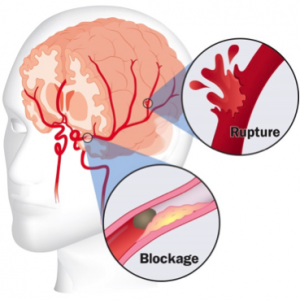
Common causes of stroke come from blood vessels both outside and inside the brain. Atherosclerosis (hardening of the arteries) can occur when plaque (deposits of cholesterol, calcium, non-organic fat, and other substances) builds up and narrows the vessel, making it easy for clots to form and further occlude the vessel. The clots can break free only to travel to and block smaller vessels inside the brain. The blood vessels inside the brain itself can accumulate this plaque. Occasionally, weakened vessels can burst and bleed into the brain.
A stroke, also known as a cerebrovascular accident or CVA is when part of the brain loses its blood supply and the part of the body that the blood-deprived brain cells control stops working. This loss of blood supply can be ischemic because of lack of blood flow, or hemorrhagic because of bleeding into brain tissue.
A strokes can lead to death or permanent disability. There are opportunities to treat ischemic strokes but that treatment needs to be started in the first few hours after the signs of a stroke begin.
A transient ischemic attack (TIA or mini-stroke) describes an ischemic stroke that is short-lived where the symptoms resolve spontaneously. This situation also requires emergency assessment to try to minimize the risk of a future stroke. By definition, a stroke would be classified as a TIA if all symptoms resolved within 24 hours.
Symptoms of Narrowed Arteries and Smartphone

Initial symptoms of a stroke can occur in someone suddenly. Know these signs of a stroke:
- Difficulty speaking
- Difficulty understanding or confusion, especially with simple tasks
- Difficulty with muscle strength, especially on one side of the body
- Numbness, especially on one side of the body
- Severe headache
- Vision changes (in one or both eyes)
- Difficulty with swallowing
- Facial droop on one side
F.A.S.T. Test
- F means face: If one side of the face droops, it’s a sign of a possible stroke
- A means arms: If the person cannot hold both arms out, it’s another possible stroke sign
- S means speech: Slurring words and poor understanding of simple sentences is another possible stroke sign
- T means time: If any of the FAS signs are positive, it’s Time to call an ambulance.

Remember the FAST test for stroke. The “T” in FAST also means the longer the brain is blocked from its blood supply (usually due to a blood clot), the greater the brain damage possible.
For many patients, the time limit to diagnose and treat such a clot is usually within 3 hours (some physicians suggest a bit longer). In some qualified patients, the use of a clot-busting drug may be used to dissolve the clot and restore blood flow. Not all patients qualify for this treatment. There are also some risks like bleeding associated with this treatment that may cause problems.
Diagnosing with Smartphone Narrowed Arteries and Types of Strokes
There are two main types of strokes (ischemic and hemorrhagic) and in allopathy as well as in Homeopathy, they are treated differently. They are often emergently diagnosed by a head CT scan (or an MRI scan).
Ischemic Stroke
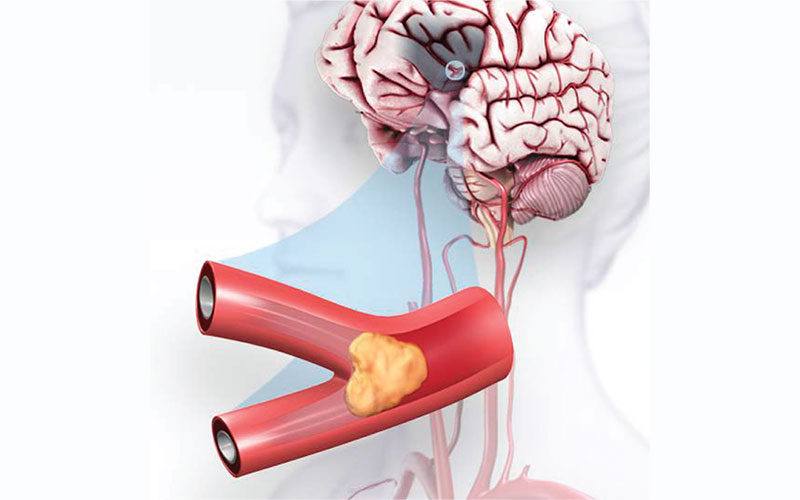
Ischemic strokes are caused by clots that reduce or stop blood flow to the brain. The clot may develop elsewhere in the body and circulate to become lodged in a blood vessel in the brain, or the clot may originate in the brain.
Ischemic strokes are usually divided into two main subtypes: thrombotic and embolic.
Thrombotic Stroke
Thrombotic strokes are caused when blood clots form in the brain due to a diseased or damaged cerebral artery. Nearly half of all strokes are thrombotic strokes.
Embolic Stroke
Blood clots also cause embolic strokes. In the case of embolic strokes, the blood clot forms in an artery outside the brain. Often these blood clots start in the heart and travel until they become lodged in an artery of the brain. The physical and neurological damage embolic strokes cause is nearly immediate.
Hemorrhagic Stroke and Smartphone and Narrowed Arteries

A blood vessel in the brain breaks open, and blood escapes into the brain under pressure, compressing other blood vessels and brain cells causing damage and death. This bleeding into the brain is difficult to stop and is more likely to be fatal. There are two types of hemorrhagic strokes: intracerebral and subarachnoid.
Intracerebral Stroke
Intracerebral (within the brain) and it refers to a stroke caused by a diseased blood vessel bursting within the brain. Intracerebral strokes are usually caused by high blood pressure.
Subarachnoid Stroke
A subarachnoid hemorrhage refers to bleeding immediately surrounding the brain in the area of the head called the subarachnoid space. The main symptom of a subarachnoid stroke is a sudden, severe headache, possibly following a popping or snapping feeling. Many factors can cause a subarachnoid stroke, including head injury, allopathic blood thinners, bleeding disorders and bleeding from a tangle of blood vessels known as an arteriovenous malformation.
Mini-Stroke (TIA)
“Mini-strokes” (also termed transient ischemic attacks or TIAs) are temporary blockages of blood vessels in the brain. TIAs can produce mild stroke symptoms that resolve. TIAs often occur before a stroke happens, so they serve as warning signs that the person may need stroke preventive therapy.
Mini Stroke Symptoms
- Confusion
- Weakness
- Lethargy
- Paralysis
- Facial droop
- Vision loss
Mini Stroke allopathic treatment
Treatment for a mini-stroke may include medication, changes in lifestyle, and possibly surgery to reduce the chances of another stroke occurring.
Surgery after Smartphone and Narrowed Arteries diagnosis

There are some surgical options for stroke prevention. Some patients have plaque- narrowed carotid arteries. The plaque can participate in clot formation in the artery and can even shed clots to other areas in the brain’s blood vessels. Carotid endarterectomy is a surgical procedure in which the surgeon removes plaque from the inside of the arteries to reduce the chance of strokes in the future.
Balloon and Stent

Some doctors also treat plaque-narrowed carotid (and occasionally other brain arteries) with a balloon on the end of a narrow catheter. Inflating the balloon pushes plaque aside and increases the vessel’s lumen (opens up the vessel). This opened artery then is reinforced (kept open) by an expandable stent that, when expanded, becomes rigid.
Emergency stroke allopathic treatment
Emergency stroke treatment depends on the type of stroke and underlying health of the patient. Ischemic strokes are treated by methods designed to remove (dissolve) or bypass a clot in the brain, while hemorrhagic strokes are treated by attempts to stop the bleeding in the brain, control high blood pressure, and reduce brain swelling. Hemorrhagic strokes are more difficult to treat.
Aspirin
Aspirin is part of a group of drugs called antiplatelet agents. Antiplatelet agents like aspirin help prevent blood cell fragments from sticking together and forming clots and are therefore helpful in preventing some forms of stroke. The American Heart Association recommends taking aspirin within two days of an ischemic stroke to reduce the stroke’s severity. For those who have had a mini-stroke, a doctor may recommend daily aspirin treatment.
TPA
TPA is a clot-busting drug that can be used to treat ischemic strokes. It is given through the arm as an IV and helps dissolve blood clots and improve blood flow through areas of the brain blocked by clots. TPA may help if it is used within three hours of a stroke taking place.
Prescribed Medications and Side Effects

Allopathic medicines are designed to lower risk by inhibiting clot formation (aspirin, warfarin and/or other antiplatelet medicines). Also, antihypertensive medications can help by reducing high blood pressure.
But almost 98% allopathic medications have severe side effects, so be very careful to prescribe allopathic medicines to your patients.
Stroke Prevention
Common conditions that increase a person’s risk for strokes include high blood pressure, elevated cholesterol levels, diabetes, and obesity. People can reduce stroke risks by addressing these problems.
Lifestyle Changes

People can also reduce their stroke risk by altering some aspects of their lifestyle. For example, people who stop smoking, begin a consistent exercise program, and limit their alcohol intake (two drinks per day for men, one per day for women) can decrease their risk.
Diet

One of the best ways to reduce stroke risk is to eat a diet that has low fat and low cholesterol to reduce the chance of plaque formation in blood vessels. Foods high in salt may increase blood pressure. Cutting back on calories can help reduce obesity. A diet that contains a lot of vegetables, fruits, and whole grains, along with more fish and less meat (especially red meat) is suggested to lower stroke risk.

The methods previously discussed that may prevent or decrease a person’s stroke risk are essentially the same for people who have had a stroke (or TIA) and want to prevent or decrease their chances of having another stroke. In summary, quit smoking, exercise, and if obese, lose weight. Limit alcohol, salt, and fat intake and get into the habit of eating more vegetables, fruits, whole grains, and more fish and less meat.
Homeopathic treatment for stroke ischemia
Ferrum Metallicum
The patients needing Ferrum Met are Pale; pits on pressure; flushes readily that is frequent false flushings appearing at the slightest excitement. Vertigo, pulsating headaches and tinnitus (ringing in ears). Difficulty in breathing, shortness of breath with tachycardia (palpitations of heart); Chest oppressed; breathing difficult. Surging of blood to chest. Hoarseness. Cough dry, spasmodic. Haemoptysis, coldness of body, General coldness of extremities; head and face hot. Urine Involuntary – worse daytime
Ferrum Phos (Haemoglobin enhancer)
Ferr phos. 3x increases hemoglobin. Patient nervous, sensitive, anaemic. Dizziness. Dull headache. Delirium tremens.-Physical and mental depression Facial neuralgia; worse, shaking head and stooping. Vomiting of undigested food. Vomiting of bright red blood. Sour eructations. Haemorrhoids. Stools watery, bloody, undigested. Throbbing sensation. Vertigo. Dull, aching pain at heart; sometimes extending to back (spine). Palpitation with full pulse. Capillary congestion, with burning of skin.
Alumina
Stitching, burning pain in head, with vertigo, worse in morning, but relieved by food (blood flow moves to abdomen). Pressure in forehead as from a tight hat. Inability to walk except with eyes open. Throbbing headache, with constipation. Vertigo, with nausea; better after breakfast. Falling out of hair; scalp itches and is numb. Humming, roaring in ears. Eustachian tube feels plugged. Rectum sore, dry, inflamed, bleeding. Itching and burning at anus. Chest feels constricted. Pain along spinal cord, with paralytic weakness. Pain in arm and fingers, arms feel paralyzed. Legs feel asleep. Spinal degenerations and paralysis of lower limbs.
Plumbum Metallicum
Paralysis of single muscle. Pains in muscles. Wrist-drop. Cramps in calves. Stinging and tearing in limbs, also twitching and tingling, numbness, pain or tremor. Paralysis. Feet swollen. Pain in atrophied limbs alternates with colic. Loss of patellar reflex. Hands and feet cold. Skin yellow, dark-brown liver spots. Pale and cachectic. Yellow, corpse-like; cheeks sunken. Skin of face greasy, shiny. Tremor of naso-labial muscles. Jaundice. Dry. Dilated veins of forearms and legs. Spinal cord sclerosed. Lightning-like pains; temporarily better by pressure. Paralysis of lower extremities. Wiry pulse, camp-like constriction of peripheral arteries. Rectal neuralgia. Depression. Fear of being assassinated. Quiet melancholy. Slow perception; loss of memory; amnesic aphasia. Hallucinations and delusions. Intellectual apathy. Memory impaired. Paretic dementia. Delirium, coma and convulsions. Hypertension and arteriosclerosis. Progressive muscular atrophy. Locomotor ataxia. Excessive and rapid emaciation. Bulbar paralysis. Important in peripheral affections.
Calcarea Carb
Headache, with cold hands and feet. Raised blood coagulability. Vertigo on ascending, and when turning head. Headache from over lifting, from mental exertion, with nausea. Throbbing; cracking in ears; stitches, pulsating pain. Liver region painful when stooping. Cutting in abdomen; swollen abdomen. Incarcerated flatulence. Inguinal and mesenteric glands swollen and painful. Palpitation with feeling of coldness, with restless oppression of chest; after suppressed eruption. Skin unhealthy; readily ulcerating; flaccid. Small wounds do not heal readily. Petechial eruptions. Chilblains. Boils.
Strontium Carbonicum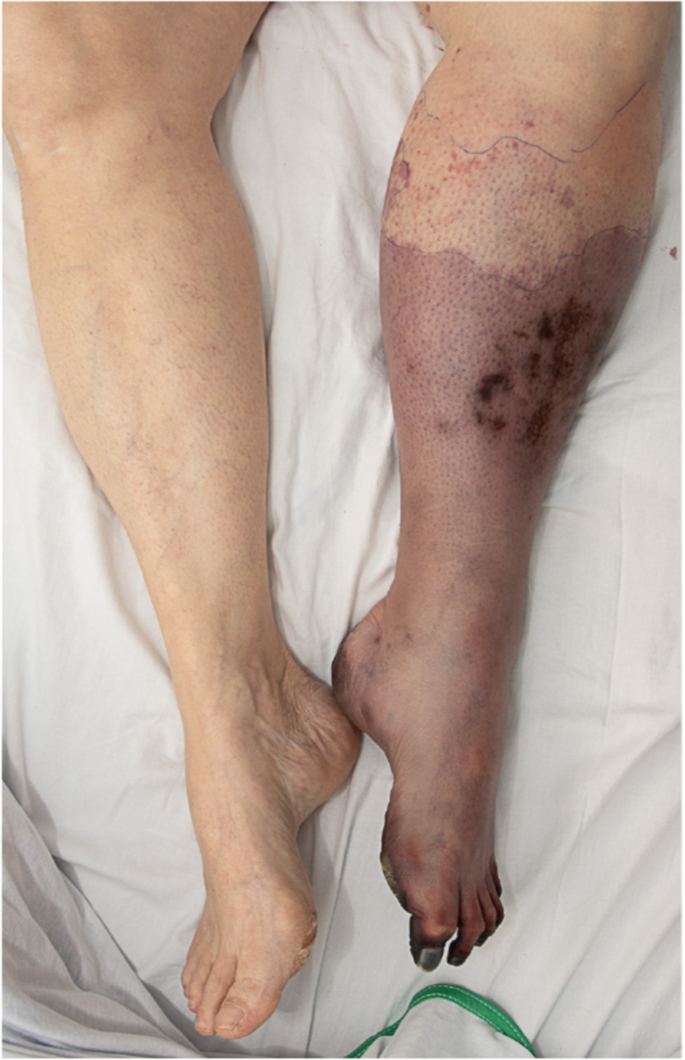
Graceful, rhythmic motions. Convulsions of upper extremities and of isolated groups of muscles. Chorea; spasms partial, constantly changing. Violent pain in left hip. Trembling, twitching of tendons, staggering gait. Arteriosclerosis. High blood pressure with flushed face pulsating arteries, threatened apoplexy.
Vertigo with headache and nausea. Distensive pressure. Aches from nape of neck, spreading upwards; better wrapping head up warmly. Flushes in face; violent pulsating. Supraorbital neuralgia; pains increase and decrease slowly (Stann). Bloody crusts in nose. Face red; burns, itches. Itching, redness and burning of nose. aversion to meat, craves bread and beer. Food tasteless. Eructations after eating. Hiccough causes chest pains; cardialgia.
Stannum Metallicum
Aching in temples and forehead, Paralytic weakness; drops things. Ankles swollen. Limbs suddenly give out when attempting to sit down. Dizziness and weakness when descending. Spasmodic twitching of muscles of forearm and hand. Fingers jerk when holding pen. Neuritis. Drawing pains in malar bones and orbits.
Aletris Farinosa
An anaemic, relaxed condition, especially of the female organism, tired all the time, and suffers from prolapsus, leucorrhoea, rectal distress, etc. Marked anaemia. Chlorotic girls and pregnant women, Confused feelings. Cannot concentrate mind. Fainting, with vertigo, Prolapse, with pain in right inguinal region. Muscular pains during pregnancy. Vertigo, with sleepiness, vomiting, purging; even stupefaction. Sharp pain in shoulder joint, streaked down arm, then into chest, settling above nipple. Knees painful sitting. Leg feels paralysed below knee, numb, could not bear weight on it. Skin itching, papillary eruption across chest and back.
China officinalis
Debility from exhausting discharges, from loss of vital fluids, together with a nervous erethism, loose of blood, the bleeding can be the result of a traumatic injury, excessive bleeding in periods or bleeding from any part of body like throat, bowels, nose, etc.
Intense throbbing of head and carotids. Spasmodic headache in vertex. Face flushed. Scalp sensitive. Dizziness. Blue color circles around eyes. Hollow eyes. Yellowish sclerotica. Black specks, bright dazzling illusions; night blindness in anaemic retina. Spots before eyes. Photophobia. Distortion of eyeballs. Intermittent ciliary neuralgia.
Hearing sensitive to noise, tinnitus, Sallow complexion. Face bloated, Liver and spleen swollen and enlarged, Menses too early. Profuse menses with pain. Irregular cardiac rhythm with weak rapid beats followed by strong, hard beats. Suffocative attacks, syncope; anaemia and dropsy. One hand ice cold, the other warm. Severe debility of extremities, trembling, with numb sensation. Drowsiness. Anxious, frightful dreams.
Natrum Mur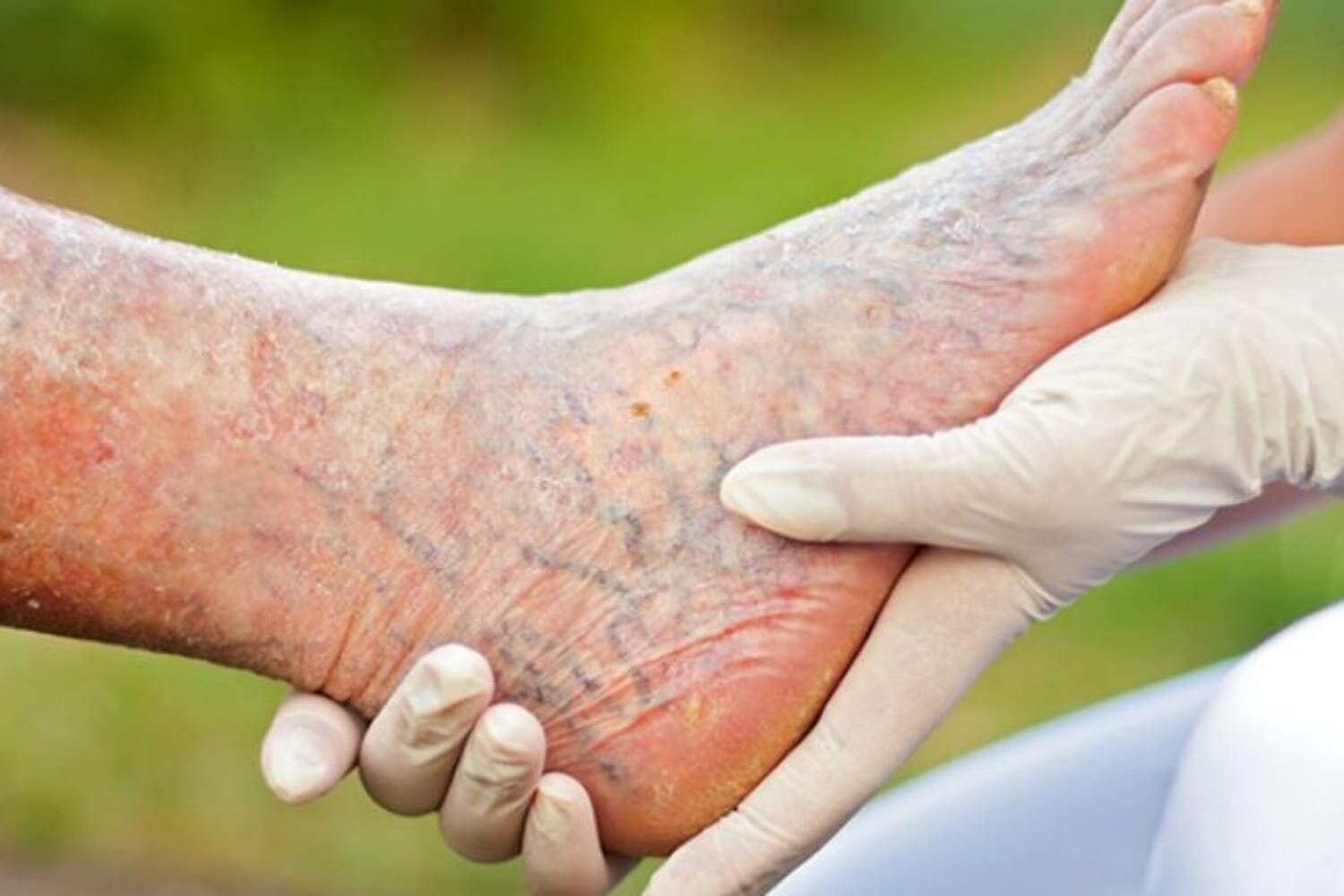
The prolonged taking of excessive salt causes profound nutritive changes to take place in the system, and there arise not only the symptoms of salt retention as evidenced by dropsies and oedemas, but also an alteration in the blood causing a condition of anaemia and leukocytosis. Anaemia, chlorosis, many disturbances of the alimentary tract and skin. Severe debility; most weakness felt in the morning in bed. Blinding headache, semi-lateral headache, pale face, nausea, vomiting, numbness and tingling in lips, tongue and nose, relieved by sleep.
Eyelids heavy. Muscles weak and stiff, Numbness, tingling of tongue, lips, and nose. Vesicles and burning on tongue, Numbness and tingling in fingers and lower extremities. Cough from a tickling in the pit of stomach, accompanied by stitches in liver and spurting of urine.
Tachycardia. Sensation of coldness of heart. Heart and chest feel constricted. Fluttering, palpitating; intermittent pulse. Heart’s pulsations shake body. Intermits on lying down.
Acid Picricum
Paralysis, prostration, weakness and pain of back, pins and needle sensation in extremities. Neurasthenia. Muscular debility. Heavy tired feeling. Myelitis with spasms and prostration. Writer’s palsy. Progressive, pernicious anaemia, Lack of will-power; disinclined to work. Cerebral softening. Dementia with prostration, sits still and listless, Vertigo and noises in ear (tinnitus). Burning along spine. Severe weakness. Tired, heavy feeling all over body, especially limbs; worse, exertion. Feet cold. Cannot get warm. Acute descending paralysis.
Phosphorus
Disorganized blood, causing fatty degeneration of blood vessels and every tissue and organ of the body and thus gives rise to haemorrhages, and haematogenous jaundice. Blood extravasations; fatty degenerations, cirrhosis, caries, loss of memory, brain feels tired, Chronic congestion of head. Brain-fag, with coldness of occiput. Vertigo, with faintness. Itching of scalp, dandruff, falling out of hair in large bunches. Partial loss of vision. Hearing difficult, especially to human voice. Re-echoing of sounds. Dullness of hearing, drowsiness.
Face pale, sickly complexion; blue rings under eyes. Hippocratic countenance. Violent palpitation with anxiety, while lying on left side. Pulse rapid, small, and soft. Heart dilated, especially right. Feeling of warmth in heart.
Ascending sensory and motor paralysis from ends of fingers and toes. Stitches in elbow and shoulder joints. Burning of feet. Weakness and trembling, from every exertion. Can scarcely hold anything with his hands.
Causticum
Paralysis, progressive loss of muscular strength. Local paralysis, vocal cords, muscles of deglutition, of tongue, eyelids, cataract with motor disturbances, vision impaired, face, bladder and extremities, Paralysis of ocular muscles. Tinnitus – Ringing, roaring, pulsating in the ears, with deafness
For consultation about Cerebral Anemia or Ischemia, flue, Respiratory tract Infection or Allergies etc; Feel free to whatsapp us or visit our clinic.
P. S : This article is only for doctors having good knowledge about Homeopathy and allopathy, for learning purpose(s).
For proper consultation and treatment, please visit our clinic.
Location, address and contact numbers are given below.
NoN of above mentioned medicine(s) is/are the full/complete treatment, but just hints for treatment; every patient has his/her own constitutional medicine.
To order medicine by courier, please send your details at WhatsApp– +923119884588
 Dr. Sayyad Qaisar Ahmed (MD {Ukraine}, DHMS), Abdominal Surgeries, Oncological surgeries, Gastroenterologist, Specialist Homeopathic Medicines.
Dr. Sayyad Qaisar Ahmed (MD {Ukraine}, DHMS), Abdominal Surgeries, Oncological surgeries, Gastroenterologist, Specialist Homeopathic Medicines.
Senior research officer at Dnepropetrovsk state medical academy Ukraine.
Location: Al-Haytham clinic, Umer Farooq Chowk Risalpur Sadder (0923631023, 03119884588), K.P.K, Pakistan.
Find more about Dr Sayed Qaisar Ahmed at :
https://www.youtube.com/Dr Qaisar Ahmed
